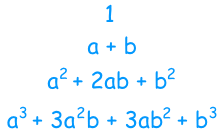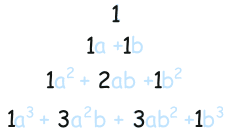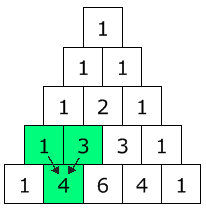So far we have: a3 + a2b + ab2 + b3
But we really need: a3 + 3a2b + 3ab2 + b3
We are missing the numbers (which are called coefficients).
Let's look at all the results we got before, from (a+b)0 up to (a+b)3:

And now look at just the coefficients (with a "1" where a coefficient wasn't shown):

They actually make Pascal's Triangle!

Each number is just the two numbers above it added together (except for the edges, which are all "1")
(Here I have highlighted that 1+3 = 4)
Armed with this information let us try something new ... an exponent of 4:
a exponent go 4,3,2,1,0: a4 + a3 + a2 + a + 1
b exponents go 0,1,2,3,4: a4 + a3b + a2b2 + ab3 + b4
Coefficients go 1,4,6,4,1: a4 + 4a3b + 6a2b2 + 4ab3 + b4
And that is the correct answer.
We have success!
We can now use that pattern for exponents of 5, 6, 7, ... 50, ... 112, ... you name it!